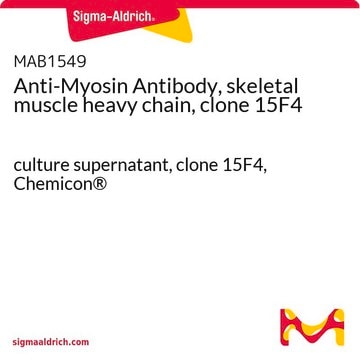MAB1548
Anti-Myosin Antibody, heavy chain β
culture supernatant, clone 5B9 (2C8), Chemicon®
Synonim(y):
Anti-CMD1S, Anti-MPD1, Anti-MYHCB, Anti-SPMD, Anti-SPMM
About This Item
Polecane produkty
pochodzenie biologiczne
mouse
Poziom jakości
forma przeciwciała
culture supernatant
rodzaj przeciwciała
primary antibodies
klon
5B9 (2C8), monoclonal
reaktywność gatunkowa
human
producent / nazwa handlowa
Chemicon®
metody
immunohistochemistry: suitable
western blot: suitable
izotyp
IgG2a
numer dostępu NCBI
numer dostępu UniProt
Warunki transportu
wet ice
docelowa modyfikacja potranslacyjna
unmodified
informacje o genach
rat ... Myh7(29557)
Specyficzność
Immunogen
Zastosowanie
Western blot: 1:10
Optimal dilutions must be determined by the end user.
Postać fizyczna
Przechowywanie i stabilność
Informacje prawne
Not finding the right product?
Try our Narzędzie selektora produktów.
polecane
Kod klasy składowania
12 - Non Combustible Liquids
Klasa zagrożenia wodnego (WGK)
WGK 2
Temperatura zapłonu (°F)
Not applicable
Temperatura zapłonu (°C)
Not applicable
Certyfikaty analizy (CoA)
Poszukaj Certyfikaty analizy (CoA), wpisując numer partii/serii produktów. Numery serii i partii można znaleźć na etykiecie produktu po słowach „seria” lub „partia”.
Masz już ten produkt?
Dokumenty związane z niedawno zakupionymi produktami zostały zamieszczone w Bibliotece dokumentów.
Nasz zespół naukowców ma doświadczenie we wszystkich obszarach badań, w tym w naukach przyrodniczych, materiałoznawstwie, syntezie chemicznej, chromatografii, analityce i wielu innych dziedzinach.
Skontaktuj się z zespołem ds. pomocy technicznej








